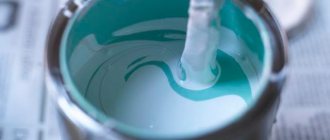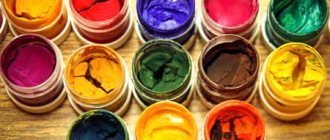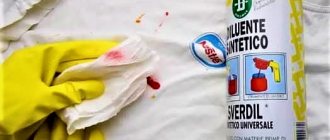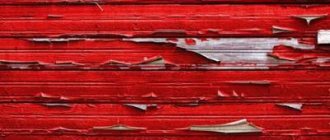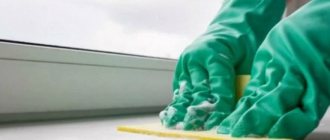Composition of acrylic paints
Paints consist of the following components:
- polyacrylates and acrylic resins, which form the basis of each layer and serve as film formers;
- surfactants, emulsifiers, stabilizers and fillers that increase the strength and wear resistance of the coating;
- organic and inorganic pigments that give color to the acrylic base;
- water, which is used as a solvent and liquid emulsion base.
Acrylic enamel, which is used for painting metal surfaces and car bodies, contains a large number of film formers. When dry, it forms a durable glossy coating that protects the metal from scratches and corrosion.
You can also get acquainted in more detail with the types of paints for cars, what acrylic paints are
Features of working with acrylic
Acrylic paints can be diluted with water or other thinners that will change their properties when drying. For example, you can add gloss by mixing with varnish or, conversely, matte with oil. You can also add shine using hairspray by sprinkling it after the paint has dried. Thanks to the solvent, it is possible to improve the fluidity of acrylic so that it is convenient to paint large surfaces or work with a paint roller.
They can be used for priming canvases and other surfaces. Using acrylic, you can get both a smooth base and a textured one.
Causes of drying out
The main reasons for acrylic paint drying out are:
- loose closure of the lid of a container with acrylic, violation of the integrity of the jar or tube;
- storage at high temperatures, under direct sunlight, etc.;
- using paint after the expiration date specified by the manufacturer;
- long-term painting, frequent opening of containers when working with the surface to be painted;
- evaporation of the solvent that was introduced to restore the paint under the influence of elevated temperatures.
The optimal consistency of the prepared paint is maintained only at a temperature of +15…+25°C. In cold weather, acrylic can become thicker, causing it to be applied in thick layers.
Preparing water for entering the palette
Since the use of water-based paints, many experiments have been carried out to improve its application. Craftsmen introduced various chemical solvents into the paint to dilute it. Thus, wanting to improve the properties of the coloring mixture.
But in most cases this led to the latter simply collapsing. Lumps formed in it, which subsequently completely refused to dissolve. And the composition lost all the necessary properties. Therefore, experts unconditionally say that the only correct solution is to use water. Because it acts as the basis of the palette.
Distilled water for diluting paint Source arteziano.ru
But before diluting water-based paint, you need to make sure that the liquid meets the required parameters. First of all, pay attention to the ambient temperature. Because the coloring composition tends to thicken faster at low degrees, and literally turn into water in high heat.
Therefore, during interior work, it is always checked that the water is at room temperature. This will prevent a lot of unnecessary problems. But outside it is recommended to use slightly heated water. This technique will slow down the thickening of the composition, which occurs faster in the open air. True, the method should only be used in cold weather.
Heating water for diluting paint Source proctologi.com
The second serious factor that can impair the quality of painting is the presence of impurities. After all, water perfectly dissolves everything that is introduced into it. And if not completely, then it is still enriched by the elements that got into it.
And this will have a detrimental effect on the characteristics of the palette. Its color may change or the necessary properties may decrease. Therefore, the best way out would be to use distilled water. There is no need to prepare it yourself by running it through a homemade apparatus. It is sold in all auto stores and most hardware stores.
But you can still remove all unwanted impurities from ordinary water at home. To do this, just boil it and let it settle. At the same time, it reaches the desired room temperature on its own. After this, you just need to carefully pour it into another container so that all the sediment remains in the original container.
Preparing water for diluting paint Source legkovmeste.ru
Difference between thinner and solvent
Thinners and solvents differ in the specific impact on acrylic resins and the purpose of addition.
Thinners are used for:
- short-term reduction in viscosity to facilitate application by brush, roller or spray gun;
- regulation of layer thickness and drying speed of the coating;
- restoration of the initial density of the composition.
Thinners do not react chemically with film formers, but only make the polymer base more liquid and fluid. When applied to a surface, they evaporate at a given rate.
Solvents act more aggressively on acrylic. They weaken the chemical bonds in the polymer, bonding the resins and converting them into a homogeneous liquid state. Aggressive substances allow you to restore dried or heavily thickened paint, but if used incorrectly, they can greatly deteriorate the quality of the coating.
How to dilute acrylic paint
The classic thinner for acrylic is water. To get a high-quality product, you need to use a liquid with a minimum amount of impurities - bottled, settled or filtered. In cases where the paint has become very thick, use a mixture of water and alcohol.
Not all dyes allow dilution. Those into which liquid can be added must be marked accordingly. If the label is worn out or missing, you can dilute a portion of the material and test it on a small area of the surface to be painted.
The thinner should be poured in small portions, stirring thoroughly after each step. When using professional solutions, you can use a construction mixer: it will ensure uniformity of the composition, preventing the paint from hardening during mixing.
Features of diluting acrylic with water
The dilution proportion depends on the desired effect:
- 1:1 - has a good balance of viscosity and spreadability, forms a solid base for applying the final layer of a similar or thicker consistency.
- 1:2 (2 parts water) - suitable for creating a base coat, applied with a fluffy roller or sponge, leaving streaks when applied with a brush.
- 1:5 - used for tinting embossed surfaces, textured wallpaper and decorative elements; it is well absorbed and leaves a visible tint. A fivefold dilution of the dye is also used when priming porous coatings. The weakly saturated pigment penetrates deeply into the surface and replaces a special primer.
- 1:15 - applied with gradient coloring to create smooth, blurry transitions.
Compositions for painting and restoration are diluted in a minimal proportion (no more than 1:1). To obtain a rich color, water-dispersed dyes are mixed with water in a ratio of 9:1 (10% diluent).
Dilution with water and alcohol
If the paint has already thickened to the point of forming clots, then alcohol or vodka will be required for dilution. To soften lumps, you need to:
- prepare a small amount of alcohol, vodka or a 1:1 alcohol solution (when using compositions, you need to take into account the water content);
- pour into a jar with pigment, mix thoroughly;
- leave for a few minutes, stir again until the lumps disappear;
- if the composition needs to be applied immediately, then additionally filter it through gauze;
- Before sending a homogeneous emulsion for storage, pour a little solvent onto its surface and tightly close the lid of the container.
paints and varnishes
Table of contents:
Features and properties of acrylic paint
About fifty years ago, acrylic paints appeared, but during this time they became the most popular among other types of this finishing material. With their help, ceilings, walls, floors, wooden, metal, and plastered surfaces are painted. Their popularity is high due to the following advantages:
Acrylic paints photo:
The main components of acrylic paint are:
The binder is a material of synthetic origin, which is called an emulsion based on polymer acrylics. The paint dries due to the rapid evaporation of water; at the end of this process, an elastic film is created that covers the surface. The paint does not crack, is frost-resistant, resistant to delamination and does not crumble.
The separation of acrylic paints occurs in relation to their:
Depending on the method of application, acrylic paints are used for painting interior or exterior surfaces. Paints can be universal or combined.
Among acrylic paints, there are types with the properties of moisture resistance, light resistance, and resistance to mechanical stress.
Acrylic paints are used not only in the construction industry, but also in the artistic field. Acrylic is used to paint glass, make ceramics, and paint on leather, paper or canvas.
Some paints differ in their scope of application, as they are intended for application to brick, concrete, plaster, wood or paint surfaces.
To paint walls, floors or ceilings in a room where there is optimal humidity and air temperature, a special type of acrylic paint is used. Its properties make it possible to cover both plastered and relief or plasterboard surfaces.
How to dilute acrylic paints
Before answering the question of how to dilute acrylic paint, let’s try to understand the reasons why this needs to be done.
According to its structure, acrylic paint has a rather thick consistency, so if it is not diluted before work, this will lead to inconvenience in application and its uneven distribution on the surface. Another reason why acrylic paint should be thinned is if it is used after being left open for a long time. If you plan to restore furniture with acrylic paint or create a painting masterpiece, then diluting it before use is mandatory. If this is not done, then traces of the tool used to apply the paint will be displayed on the structure of the surface being painted.
Acrylic paints are a type of water-based paint, so their first and main diluent is water. Although, after applying the paint, the coating becomes waterproof. Therefore, it is recommended to clean all tools that were used in the process immediately after applying the paint, before it dries.
Another thinner option is the material recommended by the paint manufacturer. To do this, you need to refer to its instructions. Special proprietary solvents change the characteristics and features of the paint, for example, making the surface glossy or matte. Therefore, before choosing a solvent, you need to know all the properties of the paint.
Diluting acrylic paint with water: proportions and features
If, however, water is chosen as a solvent for acrylic paint, then you should familiarize yourself with the recommendations that will help make the paint the desired consistency and will not affect its properties in any way.
Use only clean and cold water. Before mixing all the paint with water, you should conduct an experiment and determine the exact amount of water needed to dilute it.
Prepare a pipette or drop bottle that can be used to measure the amount of water in the drops. Start determining the proportions and consistency of the paint. The most popular proportional options for diluting paint are adding water in a ratio of one to one, one to two, one to five or one to fifteen.
We invite you to consider these options in more detail:
Dilution of acrylic paints intended for painting on walls
To create a unique masterpiece on the wall or simply to decorate it, use multi-colored acrylic paints, which are sold in small boxes. They are also used by artists to paint on canvas.
Krasnodar Agrarian University official website open day
We suggest considering recommendations for diluting such paints:
1. To avoid overdoing the amount of water, use a pipette. To dilute this paint, use a dry or important palette. If they have a cap, then place them in it.
2. Where the paint is diluted depends on how quickly it dries. It is recommended to dilute acrylic paints on damp palettes.
3. The consistency of this paint depends on what tone is required to paint the picture. If you need a bright color, dilute the paint in a ratio of one to one, otherwise, increase the amount of water.
Additional tips for thinning acrylic paint
When using water as a diluent, make sure that there are no foreign chemicals or other elements in it. It is recommended to use water that has stood for several hours. Make sure that the paint does not get on other unpainted surfaces; if this happens, it should be removed immediately with a damp cloth.
When applying paint using a spray gun, the paint composition must be uniform and of high quality. In this case, it is better to use purchased thinners recommended by the paint manufacturer. With their help, the paint consistency will be optimal for application with a spray gun.
Using a thinner for acrylic paint significantly changes its properties, namely:
For these purposes, special solvents are used, the composition of which changes the properties of the paint. Be sure to only use thinners recommended by the manufacturer. Since an unsatisfactory result of the work is possible, which will appear immediately after the paint has dried or after a certain period of time.
Adding thinner to the paint occurs gradually, and it is recommended to use a construction mixer to mix it evenly. To change the color of acrylic paint, use special toners. They allow you to get almost any color and its shade. First add a little toner to a small amount of paint, choose the color you want and apply it to the surface to see how it looks, and then add toner to the whole paint.
It is advisable that a small amount of paint remains in the jar, since it will be quite difficult to obtain the desired shade after a while, and the paint may be needed for restoration.
If acrylic paints have dried out: recommendations for restoration
After using acrylic paint, it happens that a little paint remains, and in order to return it to its previous state over time, you will need to work hard. The whole reason is that acrylic paint is water-based, and the water, after a certain period of time, gradually evaporates, when this process is completed, polymerization of the paint occurs. This process is irreversible, so the less moisture there is in the paint, the worse its quality characteristics become.
The paint restoration process should begin based on its appearance. If there are small clumps of paint in the can and it has not yet completely thickened, then you should add regular acrylic thinner or water with alcohol.
If the paint dries too much, try grinding it into powder, and then pour a little hot boiling water into the box, after a few seconds, drain the boiling water from the paint and repeat the procedure again. When the paint warms up, leave the water poured in the jar for the third time and stir the paint. Of course, the quality characteristics of such paint will be much worse than fresh paint, since it still contains small lumps and the layer on the surface being painted will become less durable.
If acrylic paint has dried to such an extent that it resembles a large and elastic lump, then it is better to throw away such paint, although before that you can try to revive it. To do this, you should grind it and heat it with boiling water, as in the previous method, but instead of ordinary water for the third time, you should add water with alcohol. In this case, the quality of the paint will suffer significantly.
Types of solvents for acrylic paints
Alcohols, esters and hydrocarbons (petroleum distillation products) can be used as solvents for acrylic paints.
Solvents are classified into several types:
- Slow (heavy) - Body 741, Body 742. They are made from substances with a high boiling point, so the drying rate of the coating after their addition is reduced. Slow solvents prevent roughness and provide good flow, which is necessary for a glossy finish. If painting work is carried out at elevated temperatures (above +25°C) and low humidity, then the use of heavy additives for acrylic is mandatory. They are also used when painting a large surface of a car.
- Medium (universal) - P-12, Body 740. Solvents of this type are suitable for external and internal work under normal conditions (+15...+25°C, humidity 50-80%).
- Fast (light) - R-5, alcohols, solvents. Solvents with the highest evaporation rates are used at lower temperatures. They provide quick adhesion to the base layer, prevent the formation of streaks and dust settling on the drying coating. When working with a spray gun, the particles of the mixture with a fast solvent harden before contacting the surface, so the strength of the coating decreases. Light additives are used mainly when painting small parts.
solvents for acrylic paints
The most common in the construction and auto repair industry are complex solvents: R-4, R-5, R-12, etc. They include toluene, acetone, butyl acetate, xylene, ethylcellosol, solvent, cyclohexanone and alcohols.
They are used to control the flow of acrylic enamels, paints and varnishes. For example, P-5 is suitable for painting and most types of coatings, while P-12 is used primarily for painting cars.
In the artistic environment, acrylic thinners are more often used - Tamiya, Khimik, etc.
How to dilute acrylic paint if it has dried
If the paint has dried and hardened, it will become impossible to soak it with water. To restore the consistency of acrylic you need:
- Remove the dry agglomerate, grind and grind it into powder.
- Pour dispersed pigment with 1 part boiling water and stir thoroughly. After the water has cooled, pass the diluted emulsion through 2-3 layers of gauze.
- Repeat dilution with warm water until the desired consistency is obtained.
The hot method negatively affects the quality of the paint. If the original mixture is intended for painting, restoration or other artistic purposes, it should be restored with special solvents.
Boiling water can be replaced with medical or isopropyl alcohol. In this case, the solvent does not need to be heated, and the paint lumps do not need to be thoroughly crushed.
Isopropyl alcohol is included in professional acrylic thinners, so it is suitable for achieving the desired thickness of paint. Experienced modelers and artists recommend using a mixture of isopropyl alcohol and glycerin (the proportion is 25 ml per 1 liter of alcohol).
Glycerin slows down the evaporation of the solvent, which avoids roughness (shagreen) and improves the spreading of acrylic.
Useful tips
Over the years of using water-based paint, real masters have gained a lot of experience. Professionals do not hide their secrets and are ready to share them with beginners. Following the recommendations, novice artists will be able to avoid common mistakes, both when diluting paint with water and when subsequently applying the palette to the surface.
If after painting there is excess diluted paint left, then you should not rush to add it to the main one. This may affect overall properties. It is better to find a suitable container with a tight lid and store the leftovers in it. Having previously provided it with a homemade label on which you need to indicate the necessary information.
Usually the thickness of the paint is determined by eye. But you can use the same manufacturer’s recommendations that are indicated on the packaging. It indicates the degree of viscosity at which coloring will occur under the most optimal conditions. To determine it most accurately, you need to rent a special device from professional painters.
A device for determining paint viscosity Source aliexpress.com
The viscometer is made in the form of a funnel with a calibration hole. It's easy to use, but you'll need a stopwatch. A certain amount of paint is poured into the device, closing the lower hole with your finger.
Simultaneously clearing the passage and turning on the stopwatch, wait until the palette completely flows out of the funnel. The obtained figures are compared with those recommended on the packaging. And if they differ, then water is added to the paint. And the process is repeated again.
If you need to paint the ceiling, you should not make the composition too liquid. Excessive addition of water will cause the paint to lose its viscosity and simply drip from the ceiling. Therefore, for the ceiling, the palette is kneaded thicker.
Original wall design with paint drips Source avto.goodfon.ru
Don't listen to bad advice. There are “experts” who claim that you can speed up the drying of water-based paint if you dilute it with a chemical solvent instead of water. This will lead to trouble. The fact is that not all thinners collapse immediately. Many of them do this after a while, directly on the painted surface. In this case, the appearance of the material will be completely and irrevocably damaged.
How to prevent paint from drying out
To avoid acrylic drying out in a jar or tube, you need to tightly close the lid of the container. For construction work, dye is often purchased with a reserve in order to be able to restore the damaged coating with an exact match of the shade.
The mixture can be stored in a pantry, warm garage, basement and other rooms. Before closing, it is necessary to thoroughly wipe the lid and neck of the jar from the coloring composition.
From time to time it is necessary to check the expiration date of paint in closed cans and its consistency in open ones. If the acrylic has thickened, you need to immediately restore it with water before the polymer base becomes dry.
When painting large surfaces, dilute the paint in portions and cover the jar tightly with a lid. To paint the car evenly, you need to slightly dilute the dye before applying the second coat. Due to the active evaporation of solvents, acrylic enamel has time to thicken while the master applies the first layer of coating.
The quality of restored dry paint is significantly reduced, so it is advisable to revive the polymer emulsion before it dries completely. To make working with the composition easier, you can use both thinners and solvents. The former allow you to adjust the consistency, while the latter bind the acrylic and speed up the curing of the finished coating.
Additional recommendations
Working with acrylic paints has nuances and secrets. Here are some of them:
The water must stand for 2-3 hours so that the impurities settle to the bottom. Only after this can it be used to dilute acrylic paints.
When applying the composition using a spray gun, work with branded solvents, adhering to the proportions recommended by the manufacturer. This way you will get a liquid of uniform consistency and achieve uniform coloring of the surface.
Rinse brushes and rollers thoroughly, especially if the work was performed with a highly diluted liquid. This composition is difficult to notice, so the particles remain between the villi. If you subsequently use paint of a lighter shade, the color will be spoiled.
Add the diluent to the composition in portions, thoroughly mixing the composition after each dose. To do this, use a special mixer.
It is not recommended to purchase the material “back to back” - it is advisable to leave a small amount of paint unused. This is necessary for spot restoration of the surface in case of accidental damage.
Regardless of what you choose to thin your acrylic paint with, test the product with a small amount of colorant. If you notice the formation of lumps, you will have to choose another option.
